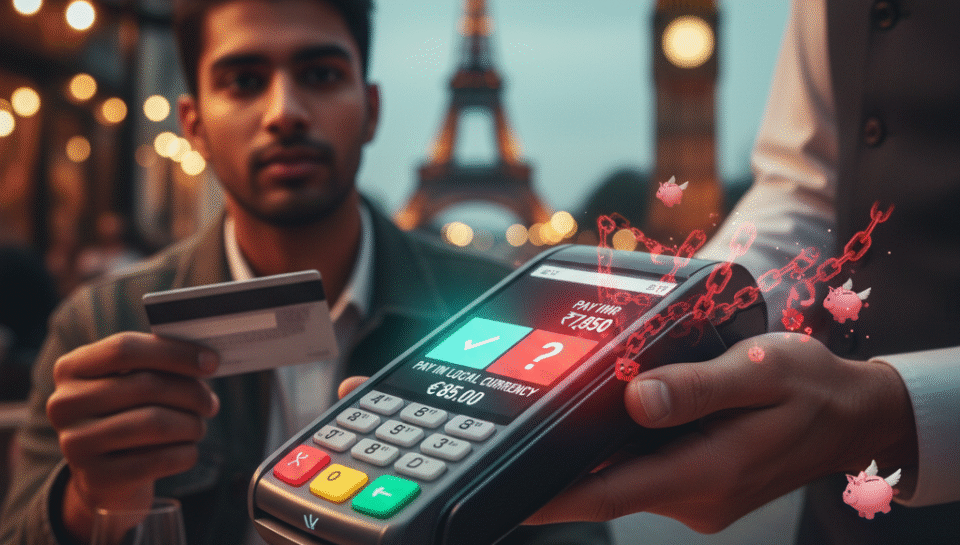You’re enjoying your international holiday, soaking in the sights and sounds. You find the perfect souvenir and take it to the counter to pay. The cashier presents the card machine with a question that seems helpful: “Would you like to pay in your home currency (INR) or the local currency?”
Choosing INR seems easier—you know exactly what you’re spending. However, in that moment of convenience, you’ve likely fallen for a costly travel trap known as Dynamic Currency Conversion (DCC).
This choice, along with other hidden charges, can silently inflate your travel expenses. As forex specialists, we are here to expose these hidden fees and provide a clear guide to help you save money and travel with confidence.
The Deceptive Choice: What is Dynamic Currency Conversion (DCC)?
Dynamic Currency Conversion (DCC) is a service offered by overseas merchants and ATMs that converts the cost of your purchase into your home currency at the point of sale. While it appears convenient, it’s a system designed to profit from unfavorable exchange rates set by the merchant’s bank, not by Visa or Mastercard.

The Downsides:
Terrible Exchange Rates : : The biggest issue with DCC is the exchange rate. It is never in your favor and includes a significant markup, often 4% to 7% higher than the rate your own bank would provide. You have zero control over this inflated rate.
Hidden Markups: The “convenience” of seeing the price in INR comes with a hidden fee baked into the poor exchange rate. This is a non-transparent way for the foreign bank or merchant to make an extra profit from your transaction.
A False Sense of Clarity: While you see the cost in INR, you are not actually saving any money. In reality, you are paying a significant, hidden premium for a simple currency calculation that your own bank would do for much less.
The Other Hidden Costs: More Than Just DCC
Even if you correctly avoid DCC, using your regular Indian debit or credit card abroad comes with other guaranteed fees.


Foreign Currency Markup Fees: When you correctly choose to pay in the local currency, your Indian bank still charges a fee for converting the transaction in your statement. This fee typically ranges from 2.5% to 3.5% + GST on every single swipe.
Steep ATM Withdrawal Fees: Taking cash out using your Indian debit card is doubly expensive. You are charged a high flat fee by your Indian bank (up to ₹600) plus another fee by the local ATM operator.
The Verdict: The Smartest Way to Pay
While DCC is the most deceptive fee, the combination of charges makes your regular debit card an expensive tool for foreign travel. The clear winner for cost-effectiveness and security is the Forex Card.
Let’s look at a practical example. Assume you make a purchase worth €200.
Paying with Debit Card (Using DCC): With an inflated DCC rate, your transaction could cost you an extra €12 (approx. ₹1,100) right at the counter!
Paying with Debit Card (in Local Currency): You avoid DCC, but you still pay the bank’s markup fee of ~3.5%, which is an extra €7 (approx. ₹650).
Paying with a Forex Card: You would pay €0 in conversion fees on the swipe. Since the card is already loaded with Euros, there is no DCC option and no markup fee. You instantly save a significant amount.
The golden rule is simple: Always choose to pay in the local currency. But to truly eliminate hidden fees, the smartest choice is to use a payment method designed for international travel.
Ready to Travel Smarter?
Before you embark on your next adventure, understanding how you pay is as important as deciding where you go. Avoiding the DCC trap and high markup fees is the first step to a truly budget-friendly journey.
A Forex Card is not just a product; it’s your shield against hidden fees and volatile exchange rates. Contact MyForexer today, and our experts will equip you with a Forex Card at the best rates, ensuring your trip is both memorable and economical.





